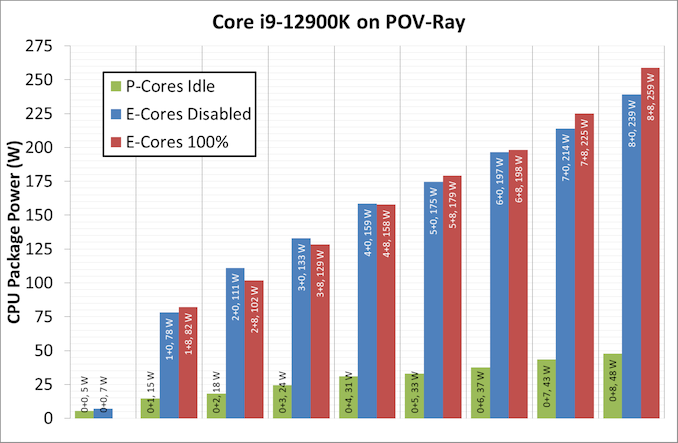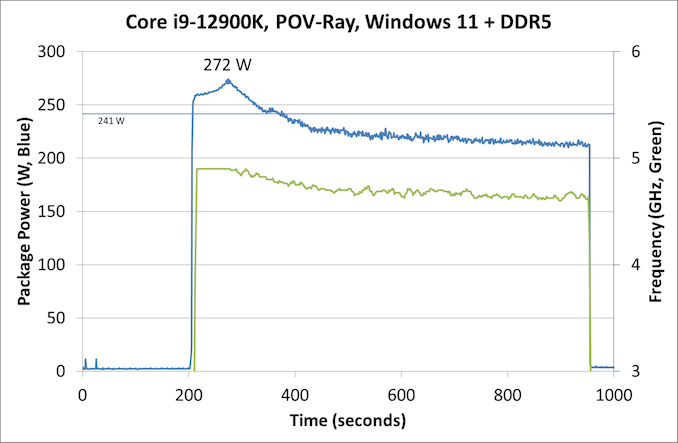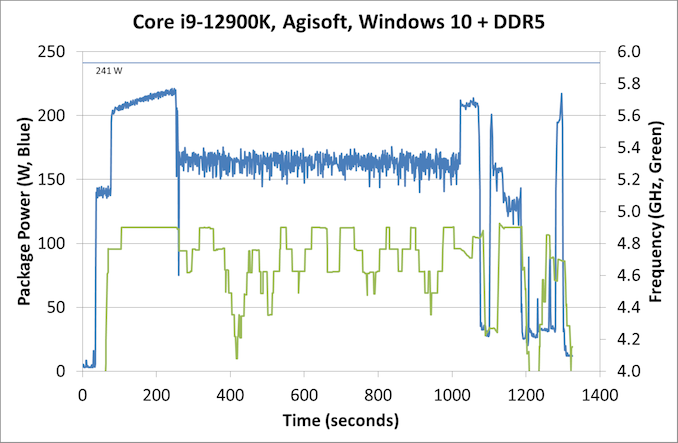The Intel 12th Gen Core i9-12900K Review: Hybrid Performance Brings Hybrid Complexity
by Dr. Ian Cutress & Andrei Frumusanu on November 4, 2021 9:00 AM ESTPower: P-Core vs E-Core, Win10 vs Win11
For Alder Lake, Intel brings two new things into the mix when we start talking about power.
First is what we’ve already talked about, the new P-core and E-core, each with different levels of performance per watt and targeted at different sorts of workloads. While the P-cores are expected to mimic previous generations of Intel processors, the E-cores should offer an interesting look into how low power operation might work on these systems and in future mobile systems.
The second element is how Intel is describing power. Rather than simply quote a ‘TDP’, or Thermal Design Power, Intel has decided (with much rejoicing) to start putting two numbers next to each processor, one for the base processor power and one for maximum turbo processor power, which we’ll call Base and Turbo. The idea is that the Base power mimics the TDP value we had before – it’s the power at which the all-core base frequency is guaranteed to. The Turbo power indicates the highest power level that should be observed in normal power virus (usually defined as something causing 90-95% of the CPU to continually switch) situation. There is usually a weighted time factor that limits how long a processor can remain in its Turbo state for slowly reeling back, but for the K processors Intel has made that time factor effectively infinite – with the right cooling, these processors should be able to use their Turbo power all day, all week, and all year.
So with that in mind, let’s start simply looking at the individual P-cores and E-cores.
Listed in red, in this test, all 8P+8E cores fully loaded (on DDR5), we get a CPU package power of 259 W. The progression from idle to load is steady, although there is a big jump from idle to single core. When one core is loaded, we go from 7 W to 78 W, which is a big 71 W jump. Because this is package power (the output for core power had some issues), this does include firing up the ring, the L3 cache, and the DRAM controller, but even if that makes 20% of the difference, we’re still looking at ~55-60 W enabled for a single core. By comparison, for our single thread SPEC power testing on Linux, we see a more modest 25-30W per core, which we put down to POV-Ray’s instruction density.
By contrast, in green, the E-cores only jump from 5 W to 15 W when a single core is active, and that is the same number as we see on SPEC power testing. Using all the E-cores, at 3.9 GHz, brings the package power up to 48 W total.
It is worth noting that there are differences between the blue bars (P-cores only) and the red bars (all cores, with E-cores loaded all the time), and that sometimes the blue bar consumes more power than the red bar. Our blue bar tests were done with E-cores disabled in the BIOS, which means that there might be more leeway in balancing a workload across a smaller number of cores, allowing for higher power. However as everything ramps up, the advantage swings the other way it seems. It’s a bit odd to see this behavior.
Moving on to individual testing, and here’s a look at a power trace of POV-Ray in Windows 11:
Here we’re seeing a higher spike in power, up to 272 W now, with the system at 4.9 GHz all-core. Interestingly enough, we see a decrease of power through the 241 W Turbo Power limit, and it settles around 225 W, with the reported frequency actually dropping to between 4.7-4.8 GHz instead. Technically this all-core is meant to take into account some of the E-cores, so this might be a case of the workload distributing itself and finding the best performance/power point when it comes to instruction mix, cache mix, and IO requirements. However, it takes a good 3-5 minutes to get there, if that’s the case.
Intrigued by this, I looked at how some of our other tests did between different operating systems. Enter Agisoft:
Between Windows 10 and Windows 11, the traces look near identical. The actual run time was 5 seconds faster on Windows 11 out of 20 minutes, so 0.4% faster, which we would consider run-to-run variation. The peaks and spikes look barely higher in Windows 11, and the frequency trace in Windows 11 looks a little more consistent, but overall they’re practically the same.
For our usual power graphs, we get something like this, and we’ll also add in the AVX-512 numbers from that page:

Compared to Intel’s previous 11th Generation Processor, the Alder Lake Core i9 uses more power during AVX2, but is actually lower in AVX-512. The difficulty of presenting this graph in the future is based on those E-cores; they're more efficient, and as you’ll see in the results later. Even on AVX-512, Alder Lake pulls out a performance lead using 50 W fewer than 11th Gen.
When we compare it to AMD however, with that 142 W PPT limit that AMD has, Intel is often trailing at a 20-70 W deficit when we’re looking at full load efficiency. That being said, Intel is likely going to argue that in mixed workloads, such as two software programs running where something is on the E-cores, it wants to be the more efficient design.














474 Comments
View All Comments
SystemsBuilder - Saturday, November 6, 2021 - link
I don't think Pat's blaming previous leadership. I am. I also blame Pat to per above.He can still fix it by being super clear about what, when, why in his communication. He needs to bring marketing messaging under control.
I can tell one thing though. I'm not buying Alder Lake CPUs. I'm probably going for Sapphire Rapids next year when the whole thing have hopefully settled a bit more.
mode_13h - Saturday, November 6, 2021 - link
> We have been lied to and spacetime can’t be warped to erase the stain on his tenure.I'd have to say that, based on your tenor, I'd be more concerned about the stain in your pants.
Now *that's* an "ad hom". You're welcome.
:D
Oxford Guy - Sunday, November 7, 2021 - link
‘I'd have to say that, based on your tenor, I'd be more concerned about the stain in your pants.Now *that's* an "ad hom". You're welcome.’
Posting drivel like that exposes your character for all to see.
mode_13h - Sunday, November 7, 2021 - link
> Posting drivel like that exposes your character for all to see.What I hope they see is that I can keep a measure of proportion about these things and not get overwrought. Not all "righteous indignation" is so righteous.
Qasar - Sunday, November 7, 2021 - link
" Posting drivel like that exposes your character for all to see."hello pot, meet kettle.
Oxford Guy - Monday, November 8, 2021 - link
Thanks for yet another fallacy, Qasar. mode is doing well enough polluting the forum with them. Help really isn’t required.Qasar - Monday, November 8, 2021 - link
you do a good job with the pollurion as well oxford guy :-)mode_13h - Saturday, November 6, 2021 - link
> The solution was to be clear and consistent.So far, they have. No AVX-512. That ASUS figured out it was still present and could be enabled isn't Intel's fault. It's like back in the days when some motherboards would let you enable dark cores in your CPU.
> Gelsinger should have said
It's not his job. Your issue is with someone at Intel several levels below him.
Oxford Guy - Sunday, November 7, 2021 - link
‘It's not his job. Your issue is with someone at Intel several levels below him.’Lying to the public (‘fused off’) is a decision that rests on his shoulders.
That isn’t the only one.
mode_13h - Sunday, November 7, 2021 - link
> Lying to the public (‘fused off’) is a decision that rests on his shoulders.Exactly where did they say it's "fused off", and when has it ever been inexcusable that hardware shipped to customers actually contains features that can secretly be enabled? This sort of thing happens all the time.